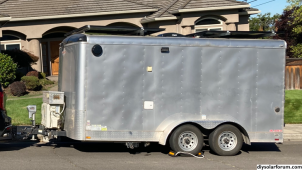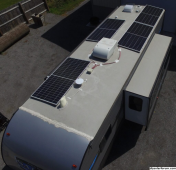Are people still moving about on wooden wagon wheels?
I keep seeing people mention rough roads and harsh rides. Just how stiff is your suspension?
No, a sprung vehicle is not a rough ride!
Springs on the suspension, air filled tires.... they do amazing things to smooth out the ride. Though your coffee drink might spill it still is not a rough ride. Stop with this. You will not break glass hitting a pot hole unless the item is poorly or improperly installed or misused or some user-error on his part, not the vehicles.
Big glass solar panels will be fine structurally on the roof, that is not at all the issue to discuss. The issue is asked if that many solar watts in one panel is a good choice or should he go with smaller panels with lesser watts each.
The cons to one or two big panels is that if one goes bad it is expensive to replace. They do go bad and not from driving around.
On mine I use multiple panels and split them into two sets of solar systems. One benefit is half the panels can be in the shade (basically useless) and the other half in the sun and I get 100% of the sunny panels available power at that tilt/etc.
I do not think there is any right answer. Many variable on your specific rig that might make sense for you and make nonsense for others, but do not think the sky is falling because a bumpy road. I have NEVER broken anything in my rig, any of my rigs, over 100,000 miles of driving all over the country, never. I have broken an axle, had blow outs, but anything above the springs has always been unharmed, never fallen down, never broken, nothing. Fine. No issues.











